#OccupyGezi: The art of the Turkish protests
Graphic Design, Illustration, Photography
Posted by Yaman Kayabali, 19 June 2013, 11:47 Permalink Comments (3)
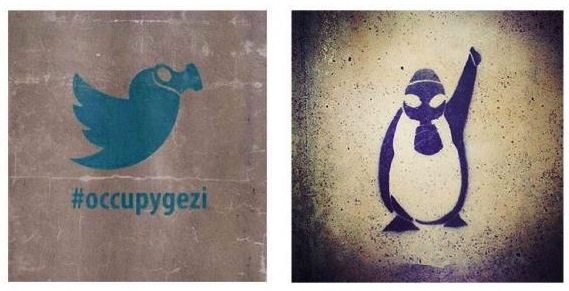
Two street stencils on walls in Istanbul
The Occupy Gezi movement started in Istanbul with the aim of preserving one of the very few green areas left in the city and turned into a group of massive, nation-wide anti-government protests. This has ignited a flurry of creative production which has resulted in a variety of posters, banners and street art...
This post was originally published on the V&A Museum's Posters blog. Our thanks to V&A curator Catherine Flood and Yaman Kayabali for permission to repost it here.
The protests that started with the Occupy movement in Istanbul have since spread to other Turkish cities such as the capital Ankara and Turkey's third largest city, Izmir.
Twitter was officially labeled as a "troublemaker" by the Turkish Prime Minister Erdogan after the start of the protests as it was instrumental in distributing information for the protestors in a time when the traditional media practiced self-censorship.
The Twitter bird wearing a gas mask is displayed in a stencil along with the most famous hashtag of the Gezi protests, #occupygezi (shown, above left). The gas mask, which has now become an everyday object for the Turkish protestors, is a reference to the enormous amount of teargas used by the police.
On the other hand, the stencil of a defiant penguin who also wears a gas mask (above right) symbolises the media corruption in Turkey. Penguins are now associated with the self-censorship of the mainstream Turkish media after CNN Turk, a major news channel, broadcast a documentary on penguins while the civil protests and police violence were at their peak – instead of covering what was happening on the streets.
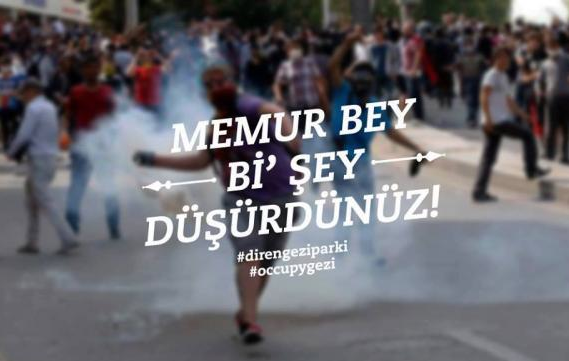
Digital poster depicting a protester throwing a tear gas canister. The text reads 'Mr Officer You Dropped Something'
Turkish police have been harshly criticized by the protestors due to the use of an unprecedented amount of tear gas, as well as the police violence witnessed during the protests.
Yet, among the images that are circulated in the social media which support the protestors and criticise the government or the police, humour dominates. The text in the digital poster above reads 'Mr. Officer You Dropped Something' – it is written on a blurred photo in which an activist is throwing back an active tear gas canister back at the riot police.
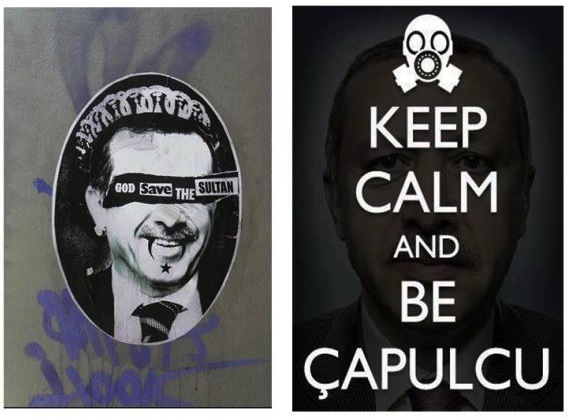 Two posters featuring portraits of the Turkish Prime Minister
Two posters featuring portraits of the Turkish Prime Minister
The street art shown, above left, plays with the image of Sex Pistols' iconic album cover by inserting the portrait of the Turkish Prime Minister in place of the Queen's.
The word 'Queen' is changed to 'Sultan', a reference to the absolute monarchs of the Ottoman Empire, the ruling state of Turkey before the modern Republic. It is also a testament of the international legacy of punk and its relevance today in the midst of public rebellion.
The digital poster shown, above right, uses Prime Minister Erdogan's portait by the photographer Platon in the background and displays the phrase 'Keep Calm And Be Capulcu'. The Prime Minister had used the word "capulcu" – which means looter – to describe the activists after the protests grew in magnitude on May 31.
The word capulcu was quickly adopted by the protestors who started to define themselves as such. This has a humorous irony because the protestors did not see themselves as looters, since the dominant majority of them were well-educated urban middle class people who abstained from looting and other acts of vandalism.
The images above are also reflective of globalism today, since they refer to international icons to convey their messages.
As the Gezi protests developed, artists, designers and other creatives quickly responded to the photographs circulating on social media. Some of these images now enjoy an iconic status since they have been used over and over in different media.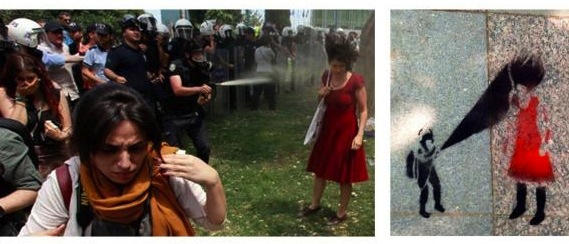
A woman in red being sprayed with pepper spray in Gezi Park and a street stencil reproducing the image
The image of a policeman blowing pepper spray on a woman in a red dress (above left), rapidly became the most recognised symbol of the protests and was transposed to the city walls, streets and roads with stencils.
The girl in red in the stencil image (above right) is considerably larger than the policeman – symbolising the growth of the resistance as the police violence got rougher.
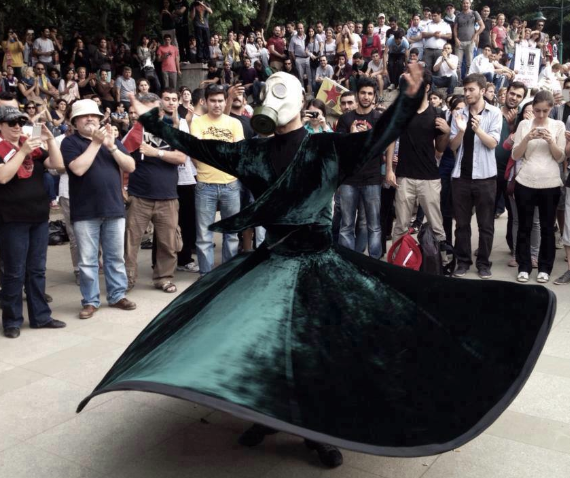

A whirling dervish wearing a gas mask while performing in Gezi Park and a street stencil reproducing the image and the phrase 'Come along!'
The image of a whirling dervish with a gas mask (above), who performed in the occupied Gezi Park was also taken up by street artists.
The phrase 'Come along!' was added in the stencil. 'Come along' is a reference to a poem by Jalal al-Din Rumi, whose followers had founded the Order of the Whirling Dervishes. The poem was written in the 13th century and it still makes a very powerful and moving statement in the context of the Occupy Gezi movement:
Come, come, whoever you are, come again. / Whether heathen, zoroastrian or idolatrous, come again, / Ours is not a caravan of despair, / Come again, even if you have broken your vow a hundred times.
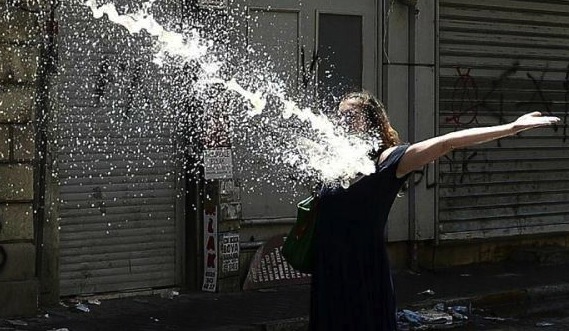
A girl in Istanbul being hit by a water cannon
Another image which rose to prominence during the protests was the girl who stood in front of a police water cannon opening her arms, exposing her torso (above).
Her image became a symbol of non-violent resistance against police force and is displayed on a variety of printed or digital posters about the protests.
Below are two digital posters created to be used in the social media. The phrase written as a hashtag in the posters – 'Diren Gezi Parki' – means 'Gezi Park Resist' and this has become one of the favourite hashtags of the Occupy Gezi movement.
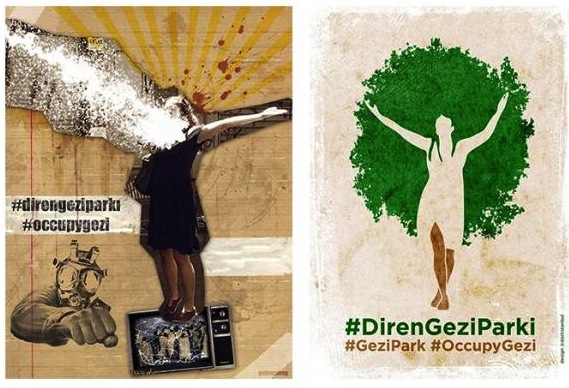
Two posters depicting the iconic image of a girl hit by a water cannon
The colourful yet simple graphic design below, which states the demands of the protestors, reflects the youthful energy of the activists.
The design is clean – each demand is symbolised by a single visual, with distinct background colours. The specific words of each demand are also emphasised by an increase in font size of certain words. This helps to convey the message clearly by avoiding a wall of text.
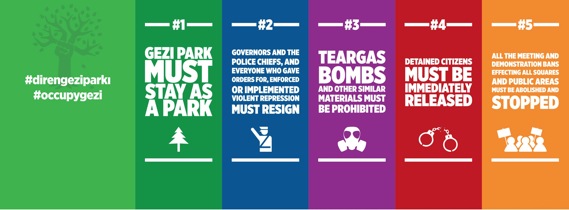
Graphic listing the Taksim Square demands
Considering that these images, which are only a handful among many, are a result of the past 15 days (since the protests began), there is going to be a lot more as the protests and the occupy movement continue.
Whatever the outcome of these events, it is certain that the artists, designers and activists have responded rapidly, with a highly creative and humorous body of works to the Occupy Gezi movement. It will definitely have a rich visual legacy for future generations.
Yaman Kayabali is a postgraduate student in the Art History and Museum Curating program of the University of Sussex. Prior to his studies at Sussex, he worked as a project coordinator in an exhibition design company in Istanbul. His area of interest is the relationship between art and politics. He is currently researching on the effects of political ideology on the early republican architecture in the new capital of modern Turkey with a comparative perspective of Turkey's Western European counterparts. Yaman is currently an intern in the Research Department at the V&A.
This post was originally published on the V&A Museum's Posters blog, here. It is reproduced with permission.